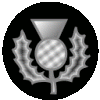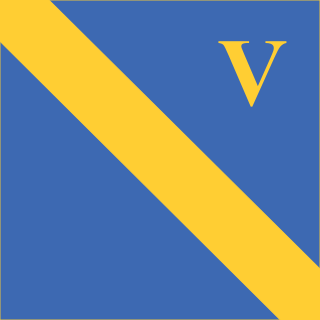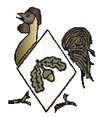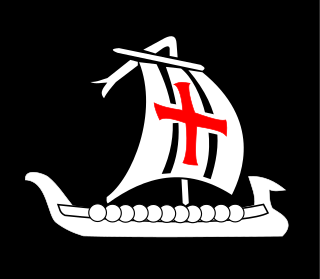The British Expeditionary Force (BEF) was the six-division British Army sent to the Western Front during the First World War. Planning for a British Expeditionary Force began with the 1906-1912 Haldane reforms of the British Army carried out by the Secretary of State for War Richard Haldane following the Second Boer War (1899–1902).

The 9th (Scottish) Division, was an infantry division of the British Army during World War I, one of the Kitchener's Army divisions raised from volunteers by Lord Kitchener to serve on the Western Front during the First World War.

The 11th (Northern) Division, was an infantry division of the British Army during the First World War, raised from men who had volunteered for Lord Kitchener's New Armies. The division fought in the Gallipoli Campaign and on the Western Front. The division's insignia was an ankh or ankhus.

The 49th Infantry Division was an infantry division of the British Army. The division fought in the First World War in the trenches of the Western Front, in the fields of France and Flanders. During the Second World War, the division fought in the Norwegian Campaign and in North-western Europe. After the Second World War, it was disbanded in 1946, then reformed in 1947. It remained with Northern Command until finally disbanded in 1967.

The 4th Infantry Division was a regular infantry division of the British Army with a very long history, seeing active service in the Peninsular War, the Crimean War, the First World War, and during the Second World War. It was disbanded after the war and reformed in the 1950s as an armoured formation before being disbanded and reformed again and finally disbanded on 1 January 2012.

The 5th Infantry Division was a regular army infantry division of the British Army. It was established by Arthur Wellesley, 1st Duke of Wellington for service in the Peninsular War, as part of the Anglo-Portuguese Army, and was active for most of the period since, including the First World War and the Second World War and was disbanded soon after. The division was reformed in 1995 as an administrative division covering Wales and the English regions of West Midlands, East Midlands and East. Its headquarters were in Shrewsbury. It was disbanded on 1 April 2012.

The 18th (Eastern) Division was an infantry division of the British Army formed in September 1914 during the First World War as part of the K2 Army Group, part of Lord Kitchener's New Armies. From its creation the division trained in England until 25 May 1915 when it landed in France and spent the duration of the First World War in action on the Western Front, becoming one of the elite divisions of the British Army. During the Battle of the Somme in the latter half of 1916, the 18th Division was commanded by Major General Ivor Maxse.

The 19th (Western) Division was an infantry division of the British Army, part of Kitchener's Army, formed in the Great War.

The 40th Division was an infantry division of the British Army active during the First World War, where it served on the Western Front. It was a division of Lord Kitchener's New Army volunteers, mostly "bantam" recruits of below regulation height. It was later briefly reformed as a fictional deception formation in the Second World War, and during the early years of the Cold War was recreated a third time to garrison Hong Kong.
The 10th Infantry Brigade was a Regular Army infantry brigade of the British Army. During World War I and World War II this brigade was part of the 4th Division.

The 29th Infantry Brigade was an infantry brigade unit of the British Army. It was originally raised in 1914 and saw service during the First and Second World Wars and the Korean War.

X Corps was a corps of the British Army that served in the First World War on the Western Front before being disbanded in 1919. The corps was re-formed in 1942 during the Second World War and saw service in the North African Campaign and the Italian Campaign where it came under command of the US Fifth Army and the British Eighth Army.
The First Army was a field army of the Romanian Land Forces, active from 1916 to 2000.
The Tenth Army was a Field army of the French Army during World War I and World War II.
The Seventh Army was a field army of the French Army during World War I and World War II.
The Sixth Army was a field army of the French Army during World War I and World War II.

V Corps was an army corps of the British Army that saw service in both World War I and World War II. It was first organised in February 1915 and fought through World War I on the Western front. It was recreated in June 1940 during World War II and substantially reorganised in 1942 for participation in Operation Torch. It fought through the Tunisia Campaign and later the Italian Campaign.
The 9th Army Corps was a large military formation of the French Army, constituted during the Second French Empire, and during the First and the Second World War.
George S. Patton served as a commissioned officer in the United States Army for 36 years. He served in three major conflicts during his military career.
The 13th Army Corps was a corps of the Imperial Russian Army, formed in the 1870s. The corps fought in the Russo-Turkish War and World War I, and was disbanded with the collapse of the Imperial Russian Army after the Russian Revolution. During peacetime, it was stationed in the Moscow Military District.










